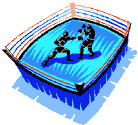Neuroscience For Kids
Boxing Knocks Out Brain Cells
September 15, 2006
![]() A boxer who steps into the ring is at risk for brain
injury. In fact, approximately 20% of professional boxers suffer chronic
traumatic brain injury. These brain injuries are caused by repeated hits
to the head. The severity of the symptoms (e.g., reduced mental ability,
speech problems, lack of coordination) depends on the number of blows to
the head, how long a boxer has fought, the skill of the boxer and the
ability to take a punch. What about amateur boxers? Does the protective
headgear and shorter duration of amateur fights reduce the risk of brain
injury? A study of Swedish amateur boxers suggests that these young
athletes DO suffer injury to neurons and glial
cells of the brain.
A boxer who steps into the ring is at risk for brain
injury. In fact, approximately 20% of professional boxers suffer chronic
traumatic brain injury. These brain injuries are caused by repeated hits
to the head. The severity of the symptoms (e.g., reduced mental ability,
speech problems, lack of coordination) depends on the number of blows to
the head, how long a boxer has fought, the skill of the boxer and the
ability to take a punch. What about amateur boxers? Does the protective
headgear and shorter duration of amateur fights reduce the risk of brain
injury? A study of Swedish amateur boxers suggests that these young
athletes DO suffer injury to neurons and glial
cells of the brain.
 A research team led by Henrik Zetterberg, M.D., Ph.D., from
Goteborg, Sweden, collected cerebrospinal fluid
(CSF) from 14 amateur boxers (11 men, 3 women) seven to ten days after
a fight and then again after three months of rest following the fight. The
CSF from the boxers was compared to the CSF collected from 10 healthy men
who were not boxers. The researchers examined the CSF from all subjects
for chemicals that would indicate injury to neurons and glial cells.
A research team led by Henrik Zetterberg, M.D., Ph.D., from
Goteborg, Sweden, collected cerebrospinal fluid
(CSF) from 14 amateur boxers (11 men, 3 women) seven to ten days after
a fight and then again after three months of rest following the fight. The
CSF from the boxers was compared to the CSF collected from 10 healthy men
who were not boxers. The researchers examined the CSF from all subjects
for chemicals that would indicate injury to neurons and glial cells.
 Soon after a fight, the boxers had increased CSF levels of
two neuron and glial chemical markers for injury compared to CSF levels
after three months of rest. Fighters who received more than 15 hits to
their head or experienced grogginess during or after the fight also had
higher CSF levels of these chemicals. Evidence of brain damage was found
even after three months of rest: levels of the chemical marker that
indicates damage to axons was higher in boxers three months after a match
than levels in nonboxer control subjects.
Soon after a fight, the boxers had increased CSF levels of
two neuron and glial chemical markers for injury compared to CSF levels
after three months of rest. Fighters who received more than 15 hits to
their head or experienced grogginess during or after the fight also had
higher CSF levels of these chemicals. Evidence of brain damage was found
even after three months of rest: levels of the chemical marker that
indicates damage to axons was higher in boxers three months after a match
than levels in nonboxer control subjects.
 These data suggest that even amateur boxing damages the brain.
Although some damage can be repaired over time, evidence of damage is
still seen three months after a fight. It is likely that professional
boxers or those who are knocked out during a fight sustain even more
damage. Further studies are needed to determine the effects of multiple
fights on the chemical markers of brain damage and how these markers are
associated with changes in mental ability.
These data suggest that even amateur boxing damages the brain.
Although some damage can be repaired over time, evidence of damage is
still seen three months after a fight. It is likely that professional
boxers or those who are knocked out during a fight sustain even more
damage. Further studies are needed to determine the effects of multiple
fights on the chemical markers of brain damage and how these markers are
associated with changes in mental ability.
References and more information, see:
- Zetterberg, H., Hietala, M.A., Jonsson, M., Andreasen, N., Styrud, E., Karlsson, I., Edman, A., Popa, C., Rasulzada, A., Wahlund, L.O., Mehta, P.D., Rosengren, L., Blennow, K. and Wallin, A. Neurochemical aftermath of amateur boxing. Arch. Neurol.63:1277-1280, 2006.
Copyright © 1996-2006, Eric H. Chudler, University of Washington
